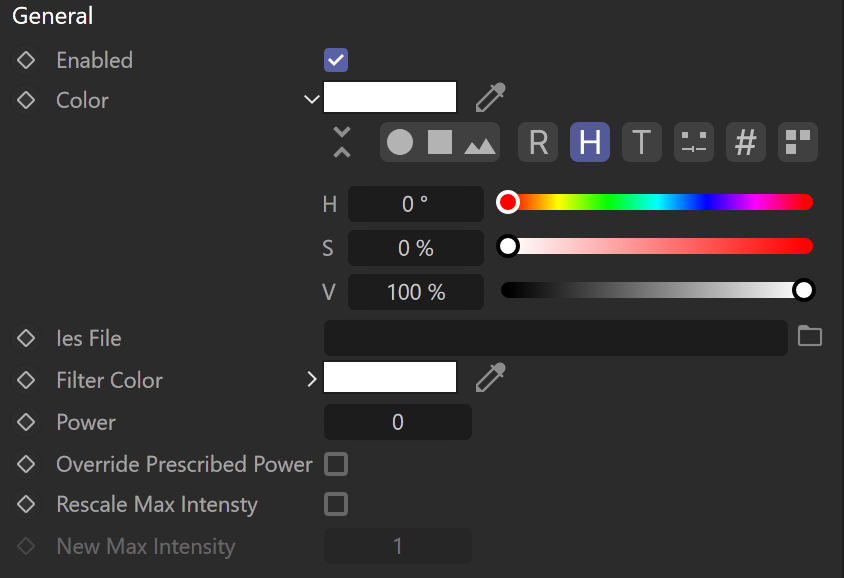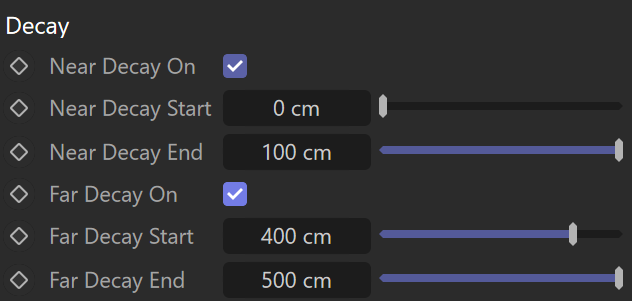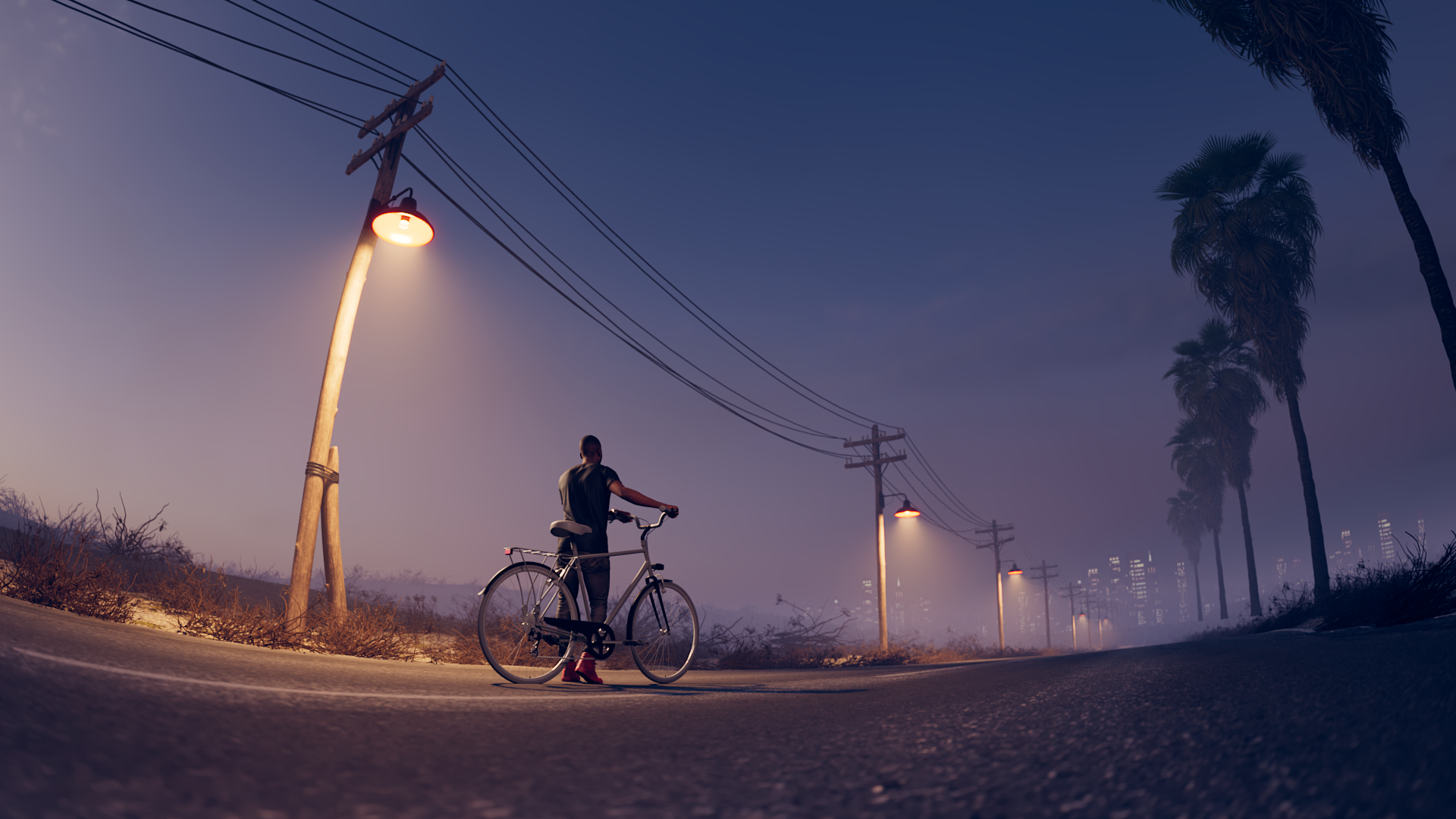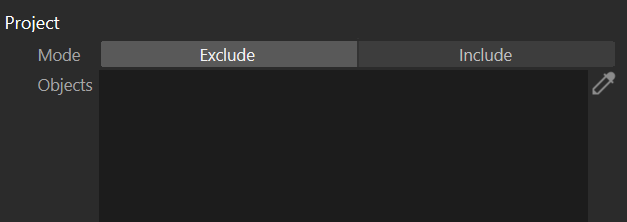This page provides information about the V-Ray IES light in Cinema 4D.
Overview
General
Enabled – Turns the light on and off.
Color – Controls the color of the light. When using photometric units, this color is normalized so that only the color hue is used, whereas the light intensity is determined by the Power parameter.
Ies File – Load an .ies file to use for the current light.
Filter Color – A multiplier for Color parameter of the light. This option is not available with V-Ray GPU.
Power – Determines the intensity of the light. The default value of 0 means the light intensity comes only from the .ies profile. If a value different than 0 is used, that number is taken as the light intensity, instead. A reasonable number would be in the range of 500-1000. The value is in lumens.
Override Prescribed Power – Overrides the power specified in the file if > 0. The value is in lumens.
Rescale Max Intensity – The IES file's default global light intensity is multiplied, so it matches the user's defined light intensity.
New Max Intensity – Specifies the strength of the light as a multiplier when Rescale Max Intensity is enabled.
Options
Affect Diffuse – Determines whether the light affects the diffuse properties of the materials.
Affect Specular – Determines whether the light affects the specular properties of the materials. This means glossy reflections.
Affect Atmospherics – When enabled, the light influences the atmospheric effects in the scene. This option is not available with V-Ray GPU.
Diffuse Contribution – Specifies a multiplier for the effect of the light on the diffuse.
Specular Contribution – Specifies a multiplier for the effect of the light on the specular.
Atmospherics Contribution – Determines the amount of influence the light has on the atmospheric effects. This option is not available with V-Ray GPU
Area Speculars – When enabled, the specular highlights are computed with the real light shape, as defined in the .ies files. For this to work, you also have to enable Soft Shadows. When this parameter is disabled, the specular highlights are computed using a point light approximation instead of the real shape. This option is not available with V-Ray GPU.
LPE Label – Allows a label to be assigned, which can be used to reference the light in a Light Path Expression. This is especially useful when working with the Light Select render element to evaluate custom light contribution in the scene.
Shadows
Shadows – When enabled (default), the light casts shadows. Turn this option off to disable shadow casting for the current light.
Shadow Color – Controls the color of shadows for the light. Note that anything different from black is not physically correct. This option is not available with V-Ray GPU.
Shadow Bias – Moves the shadow toward or away from the shadow-casting object. Higher values move the shadow toward the object, while lower values move it away. If this value is too extreme, shadows can "leak" through places they shouldn't or "detach" from an object. Other effects from extreme values include Moire patterns, out-of-place dark areas on surfaces, and shadows not appearing at all in the rendering.
Shadow Subdivs – Determines the number of subdivisions within the shadows. Higher numbers create smoother shadows. This option is not available with V-Ray GPU.
Soft Shadows – Sometimes, the .ies file contains information about the physical shape and size of the bulb. When this option is enabled, the light casts shadows according to this information. Otherwise, the light casts shadows as if it were a Point Light.
Photon Emission
This rollout is not available with V-Ray GPU.
Caustics Subdivs – Used by V-Ray when calculating Caustics. Lower values mean more noisy results, but render faster. Higher values produce smoother results but take more time.
Caustics Multiplier – A multiplier for the generated caustics by the selected object. Note that this multiplier is cumulative - it does not override the multiplier in the Caustics render rollout section.
Sampling
This rollout is not available with V-Ray GPU.
Cut-off Threshold – Specifies a threshold for the light intensity, below which the light is not computed. This can be useful in scenes with many lights, where you want to limit the effect of the lights to some distance around them. Larger values cut away more from the light; lower values make the light range larger. If you use 0.0, the light is calculated for all surfaces.
Decay
The Decay parameters determine how the light fades in and out. The Near Decay determines how light fades in. The light isn't at its maximum value at its source, but instead gradually increases until it reaches the Near end. The Far Decay determines how light fades out. The light isn't at its maximum value at its end, but instead gradually decreases after the Far start.
Decay option is useful for creating hotspots or controlling the length of a "God Rays" effect created with Environment Fog.
Near Decay On – Toggles near decay on and off.
Near Decay Start – Determines where the fade in starts. Anything before this point is rendered dark.
Near Decay End – Determines where the fade in ends. After this threshold, the light is at its full value.
Far Decay On – Toggles far decay on and off.
Far Decay Start – Determines where the fade off starts.
Far Decay End – Determines where the light reaches a value of 0, i.e. completely fades off. See the Far Decay End example for more.
Example: Far Decay End
Decay = Off
Far Decay End = 1000
Far Decay End = 250
Light Shape
IES Light Shape – Determines the shape of the light when calculating Soft Shadows. By default, the V-Ray IES Light uses the shape information stored in the .ies file. Overrides for the light shape can be specified from the list below.
From IES File
Point
Rectangular
Circular
Sphere
Vertical cylinder
Horizontal cylinder oriented along lum. length
Horizontal cylinder oriented along lum. width
Ellipse oriented along luminaire length
Ellipse oriented along luminaire width
Ellipsoid oriented along luminaire length
Ellipsoid oriented along luminaire width
Elliptic cylinder
Hor. elliptic cylinder along lum. length
Hor. elliptic cylinder along lum. width
Vertical Circle
Vertical Ellipse
Cuboid
Scale Multiplier – Specifies a multiplier for the size of the light when Light Shape is set to From IES File.
Width – Specifies the width for applicable Light Shape types.
Length – Specifies the length for applicable Light Shape types.
Height – Specifies the height for applicable Light Shape types.
Diameter – Specifies the diameter for applicable Light Shape types.
Project
Project is used to create a list of objects that can be excluded (or included) from the light's effects, such as illumination or shadow casting.
Mode – Specifies whether the objects in the list are considered included or excluded from the light's effects.
Objects – Creates a list of objects to be excluded or included. When an object is added to the list, the icons appear, which determine how the light affects the object. The icon controls whether the emitted light affects the object. The icon controls whether the shadows caused by the light affect the object. The determines whether the object's children are affected.













